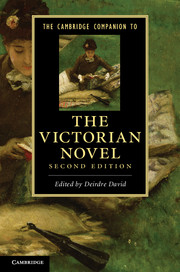Book contents
- Frontmatter
- Contents
- Notes on contributors
- Chronology
- Introduction
- 1 The Victorian novel and its readers
- 2 The business of Victorian publishing
- 3 A history of criticism of the Victorian novel
- 4 Victorian realism
- 5 Intellectual debate in the Victorian novel
- 6 Race and the Victorian novel
- 7 Social class and the Victorian novel
- 8 When gender meets sexuality in the Victorian novel
- 9 Victorian feelings
- 10 Sensation and the fantastic in the Victorian novel
- 11 The transatlantic novel in the nineteenth century
- Guide to further reading
- Index
- References
4 - Victorian realism
Published online by Cambridge University Press: 05 December 2012
- Frontmatter
- Contents
- Notes on contributors
- Chronology
- Introduction
- 1 The Victorian novel and its readers
- 2 The business of Victorian publishing
- 3 A history of criticism of the Victorian novel
- 4 Victorian realism
- 5 Intellectual debate in the Victorian novel
- 6 Race and the Victorian novel
- 7 Social class and the Victorian novel
- 8 When gender meets sexuality in the Victorian novel
- 9 Victorian feelings
- 10 Sensation and the fantastic in the Victorian novel
- 11 The transatlantic novel in the nineteenth century
- Guide to further reading
- Index
- References
Summary
At first glance, realism seems easy to grasp and define. Even the most casual readers have a strong sense of what feels lifelike to them, and consider themselves perfectly within their rights to object to implausible plots and exaggerated characters. Many critics would broadly agree that realist writers rejected allegory and symbol, romantic and sensational plots, supernatural explanations and idealized characters, and opted instead for the literal, credible, observable world of lived experience. And yet, no consensus has ever emerged among scholars about the essential qualities of a realist novel. Critics have produced a lengthy and various list of definitions over the past half-century, and new scholarly characterizations appear with remarkable frequency. The year 2008 alone saw two major contributions: Richard Menke’s Telegraphic Realism, which makes the case for the realist novel as an expression of crucial shifts in Victorian media, and Daniel Novak’s Realism, Photography, and Nineteenth-Century Fiction, which argues that Victorian realist writers drew from photography, yet, surprisingly, understood the photograph as a highly constructed, artful form rather than a transparent window onto the world. Realism has variously been associated with the ordinary, the middle class, the present, historical consciousness, industrialization, the city, and the nation; it has been linked to omniscient narration, free indirect discourse, vernacular dialogue, extended description, open-ended narrative, the panoramic, and the detail; it has been seen as a way to explore the interior lives of characters and the exterior movement of objects; it has been cast as totalizing or particularizing, as naïvely invested in transparency or as highly self-conscious about the problem of representation. Realism has also constantly crossed boundaries, claiming English, French, US, Brazilian, Japanese, Indian, and African traditions – among others – and spanning centuries, media, and genres.
- Type
- Chapter
- Information
- The Cambridge Companion to the Victorian Novel , pp. 84 - 106Publisher: Cambridge University PressPrint publication year: 2012
References
- 2
- Cited by

